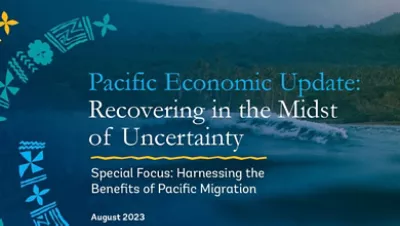The World Bank’s Pacific Economic Update provides a twice-yearly assessment of 11 Pacific Island economies: the Federated States of Micronesia (FSM), Fiji, Kiribati, Nauru, Palau, Republic of the Marshall Islands (RMI), Samoa, Solomon Islands, Tonga, Tuvalu, and Vanuatu.
This August 2023 Pacific Economic Update describes a return to growth for the region, largely due to the resumption of tourism, higher public investment and construction.
However, risks remain amid fragile global economic conditions. While global conditions have gradually improved progress on reducing inflation in major economies has proven to be more challenging than expected.
The new Pacific Economic Update also includes a special analysis of international labour migration, which was an important income source for the region during the pandemic. The report emphasises that there is a significant opportunity for Pacific countries to maximise its benefit.
The global economic recovery remains fragile, creating choppy seas for the recovering Pacific.
While global conditions have gradually improved since the pandemic and spillovers from Russia’s invasion of Ukraine, progress on reducing inflation in major economies has proven more challenging than expected.
Given that all Pacific countries are net importers, this has resulted in persistently high imported inflation.
The speed of monetary policy tightening by major central banks has slowed, but easing is unlikely in the near term.
Aggregate demand in major trading partners of the Pacific (particularly Australia and New Zealand) remains lackluster. This could limit demand for travel and tourism services and other income sources such as remittance and commodity exports.
Despite uncertainties in the global economic recovery, Pacific economies are expected to see ongoing expansion in 2023 and 2024.
Fiji led the Pacific’s post-COVID-19 recovery with open borders and a strong rebound in 2022 and is now on track to reach its pre-pandemic output level in 2023.
Ongoing recovery expectations in the Pacific are broadly in line with March 2023 World Bank projections except for Tuvalu and Palau, where growth has been revised down given weaker than expected outcomes in construction and tourism.
In 2023, Pacific growth is expected to reach 3.9 percent and then moderate to 3.3 percent in 2024 as the initial post-COVID-19 rebound dissipates and the region moves towards its long-term trend growth of 2.6 percent.
Nonetheless, uncertainty remains high and depends on whether a soft landing can be achieved among key trading partners as they battle ongoing inflation.
Inflation remained stubborn across the Pacific at an average of over 6.7 percent in 2022, a substantial increase from the 1.5 percent average during 2019-2021. This has increased the risk of vulnerable populations falling into poverty.
In line with global trends, Pacific inflation is expected to decline to an average of 6.0 percent in 2023 and gradually subside thereafter..
SOURCE: WORLD BANK/PACNEWS














